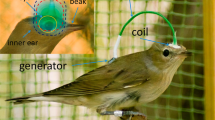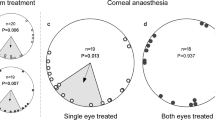Abstract
Arising from W. Wiltschko et al. Nature 419, 467–470 (2002)10.1038/nature00958; Wiltschko et al. reply
The magnetic compass of migratory birds is embedded in the visual system1,2,3 and it has been reported by Wiltschko et al.1 that European Robins, Erithacus rubecula, cannot show magnetic compass orientation using their left eye only. This has led to the notion that the magnetic compass should be located only in the right eye of birds1,3,4,5. However, a complete right lateralization of the magnetic compass would be very surprising, and functional neuroanatomical data have questioned this notion2,6,7,8. Here we show that the results of Wiltschko et al.1 could not be independently confirmed using double-blind protocols. European Robins can perform magnetic compass orientation with both eyes open, with the left eye open only, and with the right eye open only. No clear lateralization is observed.
Similar content being viewed by others
Main
More or less pronounced lateralization is a common feature of the avian brain9, but an all-or-nothing lateralization like the one reported by Wiltschko et al. in European Robins1 and Silvereyes4, Zosterops lateralis, would be highly unusual for any sensory system and seems evolutionarily counterproductive. A bird having a magnetic compass located exclusively in its right eye would be more easily affected by eye infection or monocular damage than a bird having functional magnetic compasses in both eyes.
We therefore tested 27 European Robins during autumn migration, when they use simple compass orientation10, and equipped them with light tight8,11 hoods enabling them to see with both eyes, their right eye only, or their left eye only. In all three conditions, the birds oriented in their expected autumn migratory direction towards the South-West in the unchanged geomagnetic field (normal magnetic field, NMF; both eyes open: 236° ± 20° (95% confidence intervals), r = 0.69, N = 27, P < 0.001, Fig. 1a; left eye open: 217° ± 27°, r = 0.57, N = 27, P = 0.001, Fig. 1c; right eye open: 192° ± 24°, r = 0.65, N = 26, P < 0.001, Fig. 1e) and towards the East in a magnetic field turned 120° counter-clockwise (changed magnetic field, CMF; both eyes open: 78° ± 20°, r = 0.72, N = 27, P < 0.001, Fig. 1b; left eye open: 47° ± 45°, r = 0.38, N = 26, P < 0.03, Fig. 1d; right eye open: 112° ± 30°, r = 0.52, N = 27, P = 0.001, Fig. 1f). In all cases, the CMF direction is significantly (no 95% confidence intervals overlap) turned in the expected direction compared to the NMF direction.
a–f, Each dot at the circle periphery represents the mean orientation of one individual bird tested several times with the given type of hood. mN, magnetic North. The arrows indicate the group mean vectors. The inner and outer dashed circles indicate the radius of the group mean vector needed for significance according to the Rayleigh Test (P < 0.05 and P < 0.01, respectively). The lines flanking the group mean vector indicate the 95% confidence intervals for the group mean direction.
Our results showing that European Robins have a magnetic compass in both eyes are in line with other recent findings, which otherwise would be difficult to explain: (1) garden warblers have a magnetic compass in both eyes11; (2) the putative magnetoreceptive cryptochromes are located in both eyes6; (3) Cluster N7,8, the brain area recently shown to be necessary for magnetic compass orientation in European Robins2, shows similar activation in both brain hemispheres during magnetic compass orientation7,12. In fact, Cluster N activation in European Robins shows a slight but significant dominance of the left eye and right brain hemisphere8, that is, lateralization in the opposite direction to that suggested by Wiltschko et al.1,4; (4) the neuronal pathways between the eye and Cluster N seem to be symmetrical13; (5) magnetic compass orientation is only weakly lateralized in pigeons14,15. We suggest that the Wiltschko et al.1 data may have been artefacts of the unnatural green light conditions under which their birds were tested or of the non-blinded procedures. Alternatively, they might have resulted from the more complicated interaction of map and compass information potentially occurring in spring.
In conclusion, it is very possible that some smaller degree of lateralization of magnetic information processing exists in birds8,14,15. However, our data show that the magnetic compass of night-migratory songbirds is not strongly lateralized and certainly not located in only one of the birds’ eyes.
Methods
We tested the birds’ magnetic compass orientation capabilities under broad spectrum white light2 in the normal geomagnetic field (NMF) and in a changed geomagnetic field with magnetic North turned 120° counter-clockwise (CMF). We used a double-blind protocol and large, three-dimensional, double-wrapped, Merritt 4-coils to produce highly homogenous magnetic fields (for details see ref. 2). The same current ran through the coils in both magnetic field conditions. We tested all birds inside aluminium-lined wooden huts, where no cues other than the geomagnetic field were available. The mean directions are based on 4.11 ± 2.76 (s.d.) active and oriented tests per condition (six conditions).
References
Wiltschko, W., Traudt, J., Güntürkün, O., Prior, H. & Wiltschko, R. Lateralization of magnetic compass orientation in a migratory bird. Nature 419, 467–470 (2002)
Zapka, M. et al. Visual but not trigeminal mediation of magnetic compass information in a migratory bird. Nature 461, 1274–1277 (2009)
Wiltschko, R., Stapput, K., Thalau, P. & Wiltschko, W. Directional orientation of birds by the magnetic field under different light conditions. J. R. Soc. Interface 7, S163–S177 (2010)
Wiltschko, W., Munro, U., Ford, H. & Wiltschko, R. Lateralisation of magnetic compass orientation in silvereyes, Zosterops lateralis. Aust. J. Zool. 51, 597–602 (2003)
Wiltschko, W. & Wiltschko, R. Magnetoreception in birds: two receptors for two different tasks. J. Orn. 148, S61–S76 (2007)
Mouritsen, H. et al. Cryptochromes and neuronal-activity markers colocalize in the retina of migratory birds during magnetic orientation. Proc. Natl Acad. Sci. USA 101, 14294–14299 (2004)
Mouritsen, H., Feenders, G., Liedvogel, M., Wada, K. & Jarvis, E. D. Night-vision brain area in migratory songbirds. Proc. Natl Acad. Sci. USA 102, 8339–8344 (2005)
Liedvogel, M. et al. Lateralized activation of Cluster N in the brains of migratory songbirds. Eur. J. Neurosci. 25, 1166–1173 (2007)
Güntürkün, O. in The Asymmetrical Brain (eds Hugdahl, K. & Davidson, R. J. ) Ch. 1, 3–36 (MIT Press, 2002)
Mouritsen, H. Spatiotemporal orientation strategies of long-distance migrants. in Avian Migration (eds Berthold, P., Gwinner, E. & Sonnenschein, E. ) 493–513 (Springer Verlag, 2003)
Hein, C. M. et al. Night-migratory garden warblers can orient with their magnetic compass using the left, the right or both eyes. J. R. Soc. Interface 7, S227–S233 (2010)
Feenders, G. et al. Molecular mapping of movement-associated areas in the avian brain: a motor theory for vocal learning origin. PLoS ONE 3, e1768 (2008)
Heyers, D., Manns, M., Luksch, H., Güntürkün, O. & Mouritsen, H. A visual pathway links brain structures active during magnetic compass orientation in migratory birds. PLoS ONE 2, e937 (2007)
Prior, H., Wiltschko, R., Stapput, K., Güntürkün, O. & Wiltschko, W. Visual lateralization and homing in pigeons. Behav. Brain Res. 154, 301–310 (2004)
Wilzeck, C., Wiltschko, W., Güntürkün, O., Wiltschko, R. & Prior, H. Lateralization of magnetic compass orientation in pigeons. J. R. Soc. Interface 7, S235–S240 (2010)
Author information
Authors and Affiliations
Corresponding author
Ethics declarations
Competing interests
Competing financial interests: declared none.
PowerPoint slides
Rights and permissions
About this article
Cite this article
Hein, C., Engels, S., Kishkinev, D. et al. Robins have a magnetic compass in both eyes. Nature 471, E1 (2011). https://doi.org/10.1038/nature09875
Received:
Accepted:
Published:
Issue Date:
DOI: https://doi.org/10.1038/nature09875
This article is cited by
-
Morphology, biochemistry and connectivity of Cluster N and the hippocampal formation in a migratory bird
Brain Structure and Function (2022)
-
Localisation of cryptochrome 2 in the avian retina
Journal of Comparative Physiology A (2022)
-
Protein-protein interaction of the putative magnetoreceptor cryptochrome 4 expressed in the avian retina
Scientific Reports (2020)
-
A novel isoform of cryptochrome 4 (Cry4b) is expressed in the retina of a night-migratory songbird
Scientific Reports (2020)
-
Long-distance navigation and magnetoreception in migratory animals
Nature (2018)
Comments
By submitting a comment you agree to abide by our Terms and Community Guidelines. If you find something abusive or that does not comply with our terms or guidelines please flag it as inappropriate.




